|
|
Cucurbits
> Year-Round IPM Program > Fruit Development > Identify Pests and their Damage
Cucurbits
Identify Pests and Their Damage—Fruit Development
On this page
| Arthropods |
|
Diseases |
- Cabbage looper
- Cucumber beetle adults (especially in honeydew, crenshaw, and casaba melons)
- Cutworms (in honeydew, crenshaw, and casaba melons)
- Darkling beetles
- European earwig
- Stink bugs
- Squash bugs (in squash, pumpkin, and melon)
- Whiteflies
- Armyworms
|
|
- Downy mildew
- Powdery mildew
|
Names link to information on identification and management.
Click
on photos to enlarge
| Arthropods |
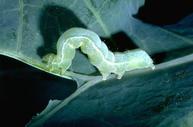
Cabbage looper
Identification tip: A green caterpillar with a narrow white stripe along each side and several narrow lines down the back; has a characteristic arch as it crawls.
Monitoring tip: Monitor adult flights with pheromone traps and observe egg laying to time treatments. |
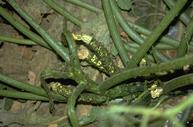
Cucumber beetle damage
Identification tip:
Beetles chew holes in young fruit. |
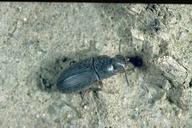
Darkling beetle adult
Identification tip: Adults vary from black or bluish black to rusty brown. Do not confuse with predatory ground beetles, which prey on various soil dwelling pests. |

European earwig
Identification tip: Adult is a slender brown insect, about 1/2 to 3/4 inch long; has pair of pincers attached to the back end of the abdomen. |
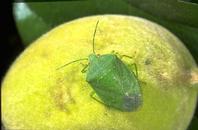
Stink bugs
Identification tip: Adult stink bugs are distinctly shield shaped, about 1/2 inch long and either brown or long; has pair of pincers attached to the back end of the abdomen. |
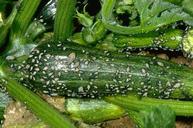
Squash bug (squash, pumpkin, melon)
Identification tip: Adults and nymphs suck plant juices. |
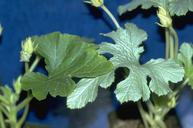
Whitefly damage (silverleaf whitefly)
Identification tip: Feeding frequently causes leaves to turn whitish or silver. It is important to distinguish silverleaf whiteflies from other species. |
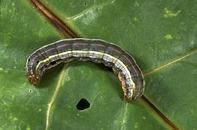
Armyworms
Identification tip: The larva is almost black, with two prominent and many fine, bright yellow stripes on the side. |
|
| Diseases |
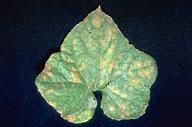
Downy mildew
Identification tip: First appears as small, pale green to yellow, angular spots between the veins. Eventually the spots coalesce and the leaf will turn brown. |

Powdery mildew
Identification tip: This disease first appears as pale, yellow spots. Spots enlarge as white, fluffy mycelium grows over plant surfaces producing spores and giving lesions a powdery appearance. |
|
Top of page
|


